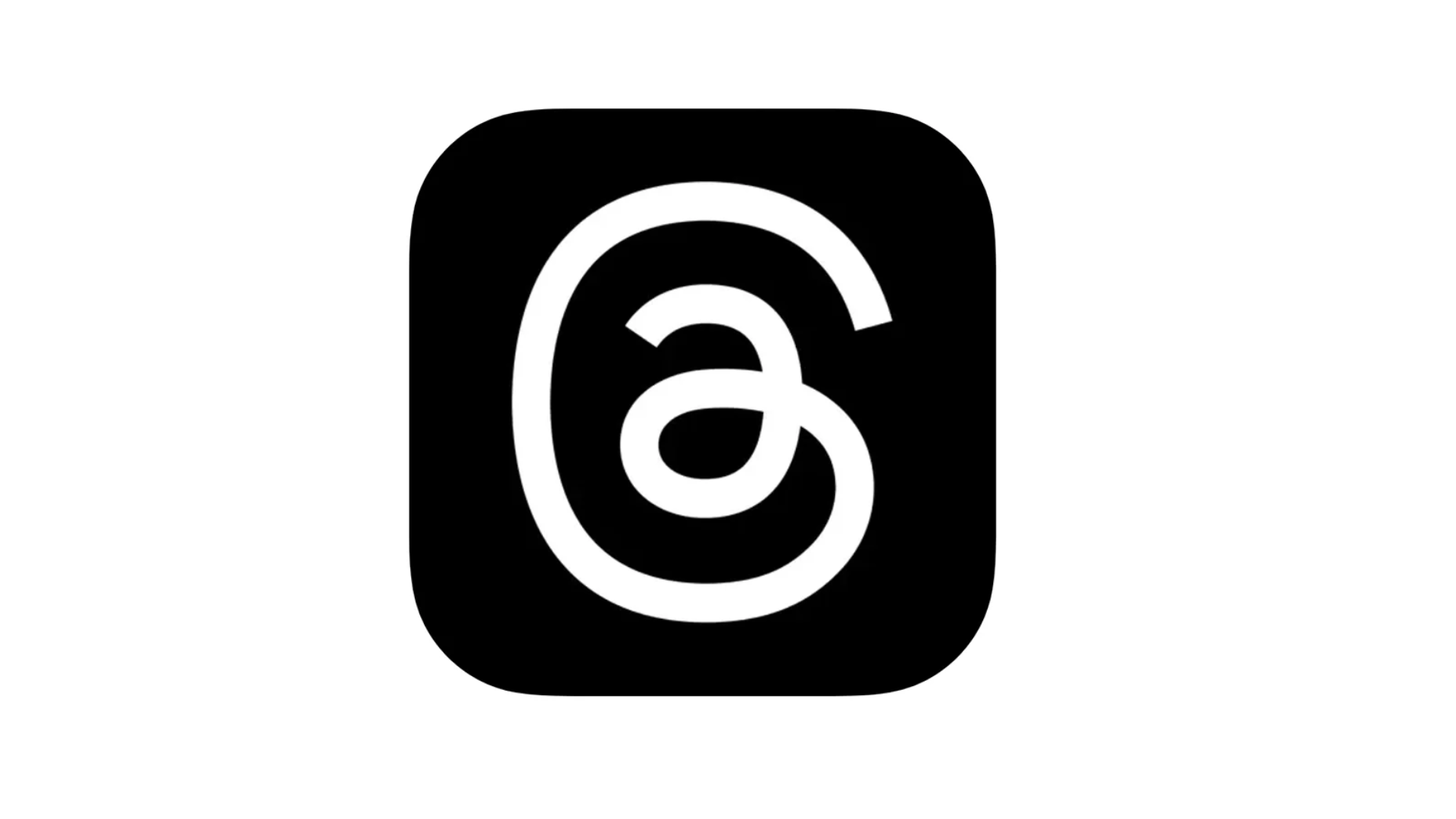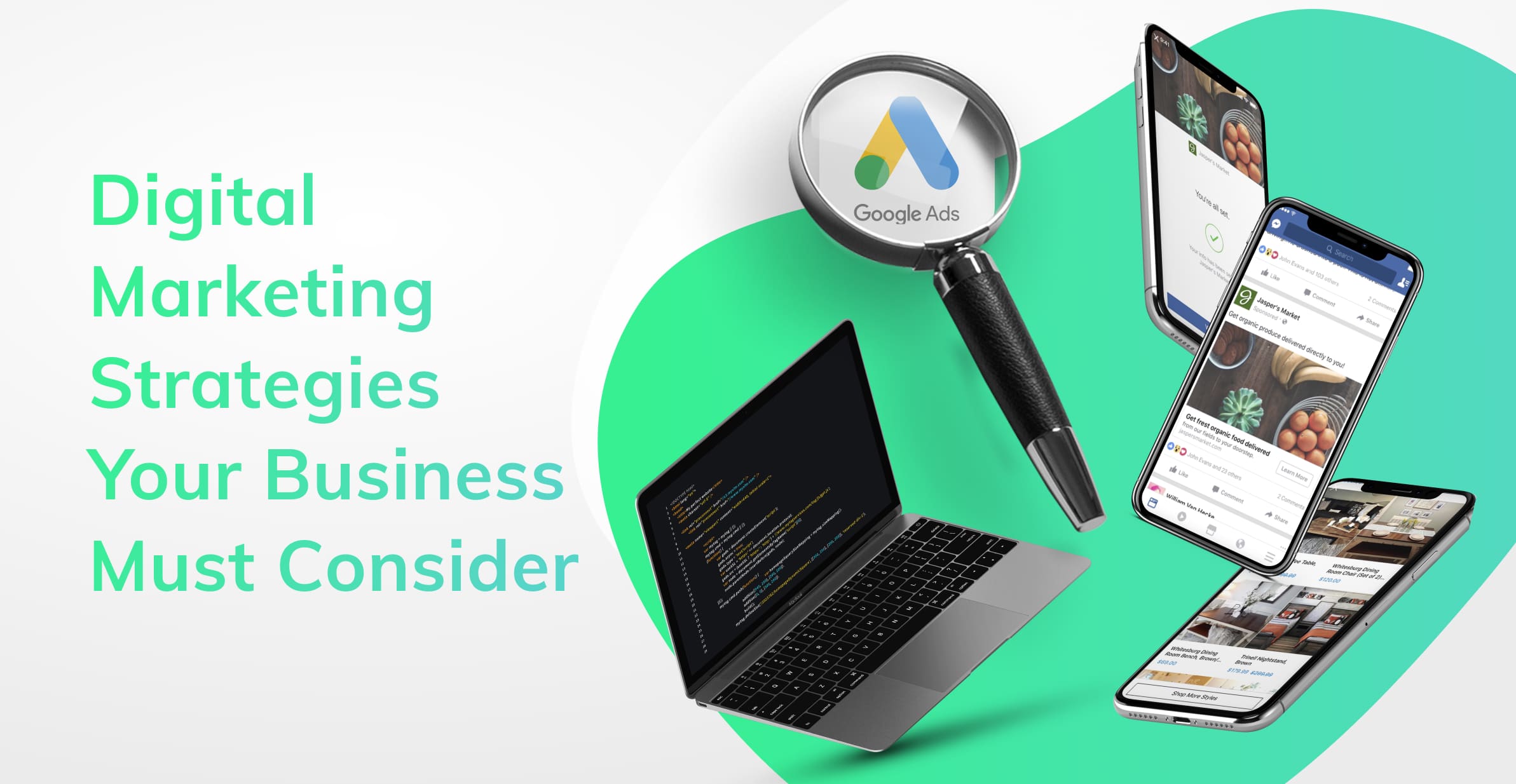One of the biggest challenges in marketing is getting traffic. It can be extremely difficult to get people’s attention, bring them to a website, and encourage them to convert into a customer or subscriber. The best way to do this is with digital marketing ads. If you know how to make them work, digital ads can dramatically increase your traffic and help you make more sales too.
Paid Ads vs Organic
Organic advertising is always a good strategy, but paid traffic may just be a smarter investment. This is because digital advertising can improve the performance of your organic growth efforts. By using digital ads you can:
- Increase brand awareness among those outside of your network
- Get to understand your audience better through targeting and analytics
- Learn what works and what doesn’t so you can improve other content.
With limited resources and the cost of generating traffic getting more expensive, digital marketing ads should be done in a way that is easy, affordable and engaging.
How to Make Awesome Digital Marketing Ads
An innovative digital marketing campaign has the power to entertain, educate, inspire as well as attract audiences to a brand. When executed well – using the right channels, touchpoints and insights – there’s so much potential for businesses to make an impact.
Studio Culture’s digital campaign manager, Portia, recommends the best ways to make great digital content that converts:
1. use time-sensitive messaging
It’s important to give people information that they’re interested in learning more about, at the right time. Whether you decide to share facts, industry insights or detailed product information, your ad should consider the bigger picture. For example, time-sensitive campaigns like holiday promotions can be extremely powerful at encouraging people to make a purchase.
Seasonal messaging tells consumers that your offer is current, which incentivises them to click through to your website. You may decide to tell people about the dreaded Christmas shopping rush, and how doing business with you can relieve this burden. This ad copy is likely to resonate with prospects and encourage them to act, rather than a simple product promotion. Whatever the occasion, your seasonal messaging should be topical, fresh and compelling.
There are a number of creative ways you can introduce time sensitive messaging into your digital advertising. These include:
- Offer free shipping for orders placed before a certain date
- Add ons or two-for-one sales for early purchases
- Make use of countdown timers
- Do giveaways on social media
Scully RSV
In this example, for Scully RSV, we used time-sensitive, seasonal messaging to encourage action. First, we informed consumers of the upcoming busy season and offered a solution (ie. book in early). By leveraging urgency with the call to action, “time is running out,” consumers felt it would be advantageous to get in early and book their Scully RSV hire before Summer.
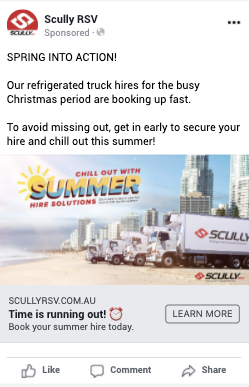
Loco Fit
For our client, Loco Fit, this promotion involved bringing a friend along for free. The imagery reflected the offer to initially grab the consumers attention. Then, if users were interested, they’d explore more and read the caption. The halloween reference lets them know that this offer is current and encourages them to make the most of it.
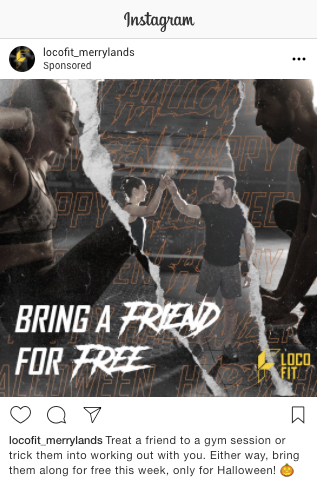
2. use on brand creative
Your brand is what makes your business stand out. So, if your brand is fun and exciting, it’s important to emphasise this to your customers every step of the way. This includes on your website, your social media channels, your product listings and your ad landing pages.
One of Portia’s main frustrations as a customer is seeing a fun and compelling ad on her feed, but upon clicking and arriving at the website, the offer feels boring and dry. This is a poor usage of creative ad imagery and copy, and often leads to an unsatisfied customer that won’t make a purchase. Portia recommends that all brand communications should be consistent, across all channels.
Macadamias Australia
Macadamias Australia brand voice is lively, quirky, fun, caring and health passionate. All the digital marketing ads campaigns we did for them were fun and exciting. For example, this reaction campaign asked consumers how they enjoy their macadamias. It generated interest while also being informal and fun to participate in. It also acts as a product awareness campaign by educating consumers about the flavours they have in stock.
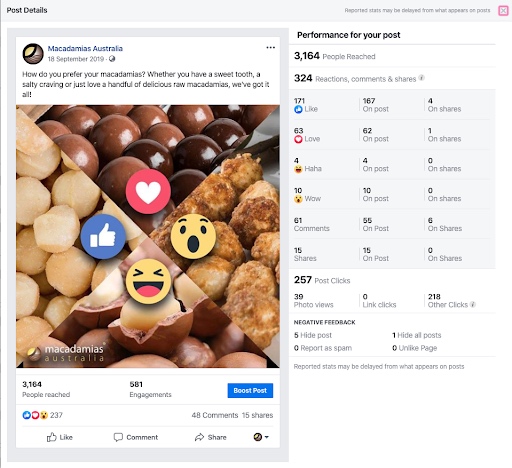
3. leverage targeting tools
Perhaps the most important element of nailing those digital marketing ads is getting them in front of the right people. Often, business owners get frustrated after receiving a large number of clicks on their ad but receiving minimal sales. To say people are complicated is an understatement, and with so many marketing messages being seen in any one day, it often takes more than one push to make it work. This is where remarketing comes in.
Facebook allows you to track visitors of your website using a simple embed pixel. By compiling a list of those who have familiarised themselves with your business, you can give your website viewers a push by remarketing to them on social media. By advertising to the small percentage of your audience that have already expressed an interest in your brand and are most likely to buy, Facebook advertising can make your ads much more relevant and effective. You can use Facebook’s Ad Manager tool to get more technical with your targeting capabilities, delving into their age, gender, interests, job titles and much more. The more precise you get with your targeting, the more likely you are to connect with interested customers and make more sales.
Blackinkk
For example, as shown with Blackinkk, we personalise the retargeting to consumers based on the specific product they were browsing instead of a general campaign. This personalisation makes consumers feel valued and consequently, builds trust in the business-consumer relationship. The extra incentive of free monogramming gives customers a slight nudge towards making a purchase.

Carina North Quality Meats
Another retargeting campaign which performed particularly well was for our client, Carina North Quality Meats. This combined a relatability aspect with an incentive for consumers who had already browsed their online butcher website. By putting a face in the ad, people can instantly relate. When combined with the copy, “don’t let all of Nick’s hard work go to waste,” people can imagine themselves in his position and feel more inclined to place an order.
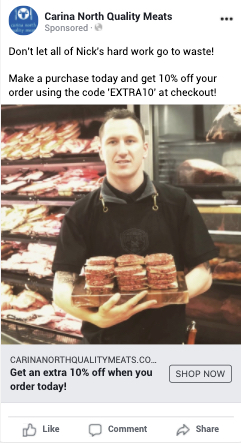
4. Use lookalike audiences
Facebook ads make it possible for you to create audiences similar to people who have already taken action on your ads or website, which is called a lookalike audience. Portia suggests making the most of this feature! This tool allows you to reach more people who share similar interests, age and gender with your current customers. As you can target people similar to those who have already made a purchase or engaged with your brand, this increases the probability of generating high-quality leads or making more sales and helps you get more value for your ad spend.
5. Adapt your messaging with different audiences
Understanding the social media marketing funnel can help you better communicate with your audience. This concept starts from the moment someone becomes aware of your brand through to the moment they make a purchase. The end goal of this marketing funnel is for a customer to become an advocate for your brand and generate positive word of mouth.
This framework can be used throughout your organic social media efforts and paid digital marketing ads to guide your customers throughout the customer journey. By incorporating social media posts that satisfy each stage of the funnel, you can effectively build trust with your customers and also raise awareness of your brand. There are five phases of the customer journey:
Marketing funnel
1. Awareness
This stage is all about people finding your brand and becoming aware that you exist. You can do this simply by offering a solution to a common problem. This particular audience isn’t interested in a hard sell of your product or service, they’re just looking for a cause that offers value. If they deem your business valuable, they’re more likely to remember your brand and explore it further.
The best way to acquire audience interest is through content. Whether it’s blogs, social media or search engine marketing, your content should answer the question your audience is asking. This will guide your audience to your website where they can learn more about your offerings and start gaining trust in your business.
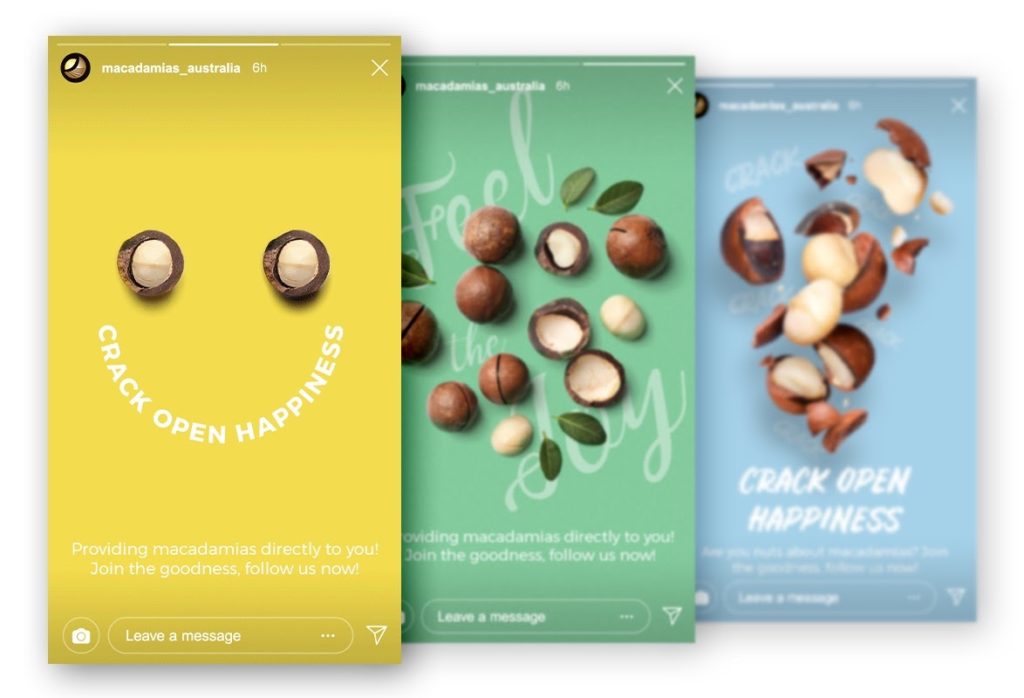
2. Consideration
Once potential customers are familiar with your brand, they will begin to search for more specific information and details that will help them decide whether to buy your product or service. This includes researching your competitors and identifying a point of difference. By providing your audience with more detailed information and reviews of your business, you can build the trust they need to make a decision.
An ad campaign in this stage may include a customer testimonial campaign, product/service tutorials and/or showcasing your product reviews. These can be directly targeted to website viewers with the help of remarketing.
Scully RSV
For example, with long-term client, Scully RSV, we created digital marketing ads with informative and inspiring content, which don’t push a hard sell. These ads were designed to get consumers familiar with the Scully brand and their values. If customers appreciate Scully’s charitable outlook, they’ll click through to the blog and learn more about the business. Once they learn more, they may be more inclined to hire through them in the future, when we do push for a hard sell.
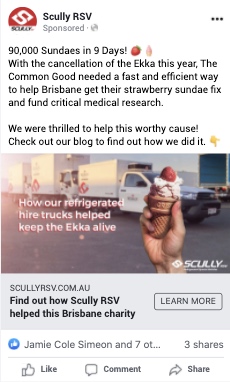
3. Conversion
In the conversion stage of the marketing funnel, using paid remarketing campaigns is the best way to continue nurturing your customers. You can provide them with valuable product information or special offers to further encourage action.
Consumers in the conversion stage already know your brand and your product/services well. They often just need a slight nudge to take the leap and make a purchase. Whether it’s offering purchase incentives like free shipping or a new customer discount, these will encourage your customers to make a purchase. In fact, 77% of shoppers say discounts influence where they shop. So, by getting in early and offering your customers a great deal, they’re more likely to conduct business with you rather than a competitor.
Loco Fit
People that have transitioned through the awareness and consideration phase of the marketing funnel tend to be very receptive to these offers. Since they may have already been debating whether or not to sign up to Loco Fit, this compound offer is likely to seal the deal and encourage them to sign up due to the great price.
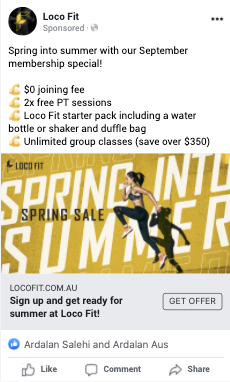
4. engagement
Once your customer has made a purchase, it’s important to continue nurturing the relationship to ensure your brand stays important to them. Digital marketing ads in the engagement stage of the funnel keep customers connected and make them feel like a valued part of your business. This involves using content that supports them. It could be after-sales care, showing off your product/service in action, promoting how-to videos or even using hashtag campaigns. All of these things encourage your consumers to become loyal to your brand, helping them to continue purchasing in the future.
Argyle Jewellers
This ad reminds people of Argyle Jewellers as their local jewellery store. If they’ve never browsed the wedding range but they are planning to get engaged, it’s likely they will click through to explore the range. Just by looking at their collection online, they will make a decision about whether it’s the right jewellery for them. This keeps them at top of mind for when the consumer wishes to purchase again.
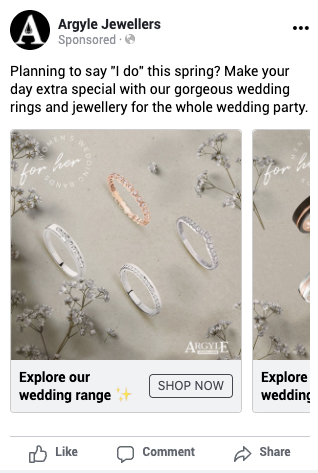
5. advocacy
This final stage is focussed on turning your customers from fans into brand ambassadors. Thank your customers, and offer them rewards for sharing their experiences with friends. You can gather reviews or incentivise your customer to share their review for a special offer. Make this easy for them by sending a direct link to your website or Facebook Business page.
Deciding What Digital Content to Create
Every business is different, so your key considerations for creating content should be based around your audience’s specific goals and challenges relating to your business. All the content that you create should follow a plan. This means having clearly defined goals, knowing which platforms your ads will be displayed on, and mapping out the key messages that are most likely to work with your audience. For more information on this, read our guide, How to Market Your Business Online.
Getting Started with Digital Marketing Ads
There are a number of platforms you can use to connect with your target customers including Facebook, Instagram, YouTube, LinkedIn or Google.
Firstly, identify which platforms your customers are most active on, and start from there. Test a couple variations of your creative imagery, ad copy and call to action buttons, and adapt your future ads with what worked best.
Contact Studio Culture
If you’d like assistance with setting up your ads accounts and retargeting pixels or are just after some creative ideas from a digitally-savvy team, please don’t hesitate to get in touch with our digital marketing agency!
